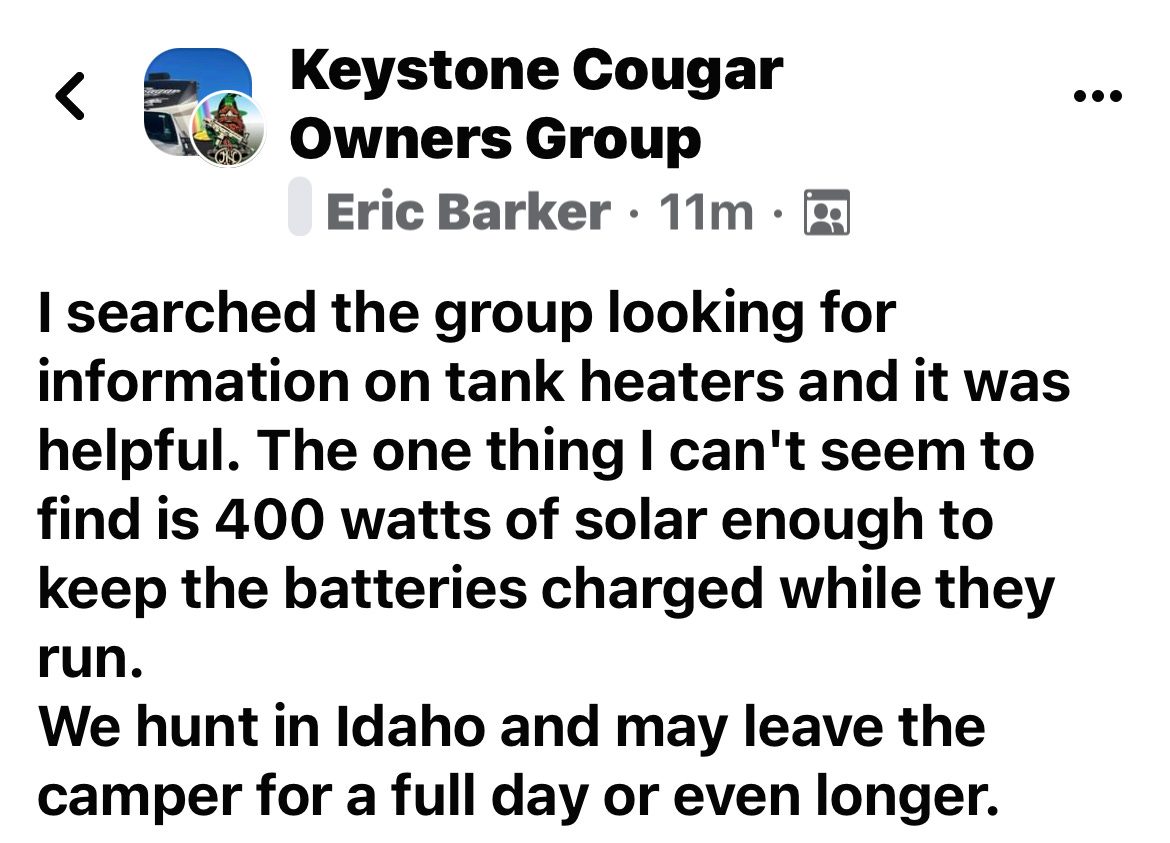Can you power tank heaters from solar panels?
It’s possible, but maybe not practical. Electric heaters use a LOT of energy… (Rerun Nov 2023)
Dear Readers,
I found this question on the Keystone Cougar Owners Group. Let’s go over the power and energy math since it’s a great way to understand how much solar and battery you need for different boondocking challenges.
First, let’s determine power requirements…
I needed to do a little research on the wattage of RV tank heaters.Here’s what I found out. There’s both 13.5 volt and 120-volt versions of heaters listed for tanks of various capacities. I’ll pick a few general sizes and run the power/energy math. That should get us in the ballpark but as they say, your mileage may vary….
Here’s what they look like
This is a typical pad heater with an adhesive panel on the back for easy installation. Be sure to follow the mounting directions as far as cleaning the tank surface, etc…. I won’t be covering installation in this article, only the solar and battery requirements.
Here’s various voltage and wattage ratings
As you can see I selected two different 13.5 Volt DC heaters and one 120-volt AC heater. I’m showing you this because it’s not really about the amperage draw, it’s all about the watts (power) and watt-hours (energy).



Heater #1
The first heater is rated for holding tanks up to 25 gallons and has a 4.1 amp current draw at 13.5 volts DC. If we want to know the wattage (power) needed, all you have to do is multiply 13.5 volts times 4.1 amps and see that it equals 55.35 watts. Note that this is power, not energy. To know the energy requirements we need to also consider how long the heater is on in addition to its wattage.
Heater #2
The second heater is rated for holding tanks up to 55 gallons and has a 9.9 amp current at 13.5 volts. If we want to know the wattage (power) needed, all you have to do is multiply 13.5 volts times 9.1 amps and see that it equals 133.7 watts. Again, this is power, not energy.
Heater #3
The third heated is rated for tanks up to 55 gallons and has a current draw of 1.37 amps at 120 volts. Now, don’t be lulled into a sense of security thinking it will draw less wattage than heater #2 (that draws 9.1 amps of current). For the same wattage load, the current at 120 volts will be 1/10th of the current at 120 volts. It’s a 10:1 (or 1:10) ratio when comparing amps at 12 and 120-volt systems. This heater power is 1.37 Amps times 120 Volts equals 166.8 Watts.
What about energy?
That depends on the Delta-T (air temperature vs desired water temp), insulation (if any), both of which will determine how long the heater must be on to keep the tanks from freezing. For this example we’ll assume a 50% duty cycle. But that number could be higher or lower depending on the weather.
Energy example #1
Let’s calculate energy of the first heater that uses 55.3 watts when it’s on. If we assume a 50% duty cycle during a 24-hour period. So 55.3 watts times 12 hours equals 663.6Wh (Watt-hrs) of energy. Basically, it will drain a 100Ah battery down to 45% SoC (State of Charge) each day. Since each 100 watts of solar panels will produce around 300 Wh (Watt-Hours) of energy, you would need at least 200 watts of solar panels to replace the energy used by this tank heater.
Energy example #2
Now lets see how much energy is used by a larger heater that’s rated for holding tanks up to 55 gallons which draws 133.7 watts. Again we’ll consider a 50% duty cycle, so 133 Watts times 12 hours equals 1,596 Wh of energy. You’ll need at least 200 Ah of batteries (2,400 Wh total) which will end up being discharged down to 44% SoC over a 24 hour period. If we divide 1,596 Wh by 300 Wh per solar panel, you’ll see that at least 500 watts of solar panels are needed to replace that energy used by the tank heater.
Energy example #3
Even though this heater draws a lot less amperage, it’s at 120 Volts so it’s still 166.8 watts. And this doesn’t count the energy loss through the inverter. So you will still need at least 200 Ah of Lithium batteries and 500 Watts of solar panels to make this work. Yikes!
So it’s possible, but maybe not practical!
Of course, I’m making a few assumptions about duty cycle, but haven’t considered other variables such as tank insulation and Delta-T (temperature difference between the tank contents and the outside air). But I’m pretty sure my numbers are in the ballpark.
The original poster could possibly run one of the these tank heaters for 24 hours from 400 watts of solar panels and 200 Ah of Lithium Batteries. But there’s not a lot of extra battery power left over for other RV appliances. It would be pretty close.
Let’s play safe out there… Mike








Most, if not all of these tank heaters turn on at 45 deg F and off at 60deg F and if you have any appreciable liquid in the tank and below freezing temps they will NOT cycle at all. Or that is at least my experience. Very very difficult to use them unless you are plugged in, especially since it is winter and cloudy and crappy as pointed out above.
I think you missed the part about winter in Idaho. No way a 100 watt Panel is going to generate 300 W/H/D in the winter in Idaho.